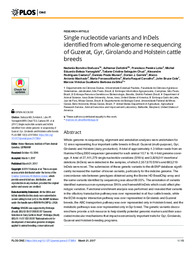Single nucleotide variants and InDels identified from whole-genome re-sequencing of Guzerat, Gyr, Girolando and Holstein cattle breeds.
Single nucleotide variants and InDels identified from whole-genome re-sequencing of Guzerat, Gyr, Girolando and Holstein cattle breeds.
Autoria: STAFUZZA, N. B.; ZERLOTINI NETO, A.; LOBO, F. P.; YAMAGISHI, M. E. B.; CHUD, T. C. S.; CAETANO, A. R.; MUNARI, D. P.; GARRICK, D. J.; MACHADO, M. A.; MARTINS, M. F.; CARVALHO, M. R.; COLE, J. B.; SILVA, M. V. G. B.
Resumo: Whole-genome re-sequencing, alignment and annotation analyses were undertaken for 12 sires representing four important cattle breeds in Brazil: Guzerat (multi-purpose), Gyr, Girolando and Holstein (dairy production). A total of approximately 4.3 billion reads from an Illumina HiSeq 2000 sequencer generated for each animal 10.7 to 16.4-fold genome coverage. A total of 27,441,279 single nucleotide variations (SNVs) and 3,828,041 insertions/ deletions (InDels) were detected in the samples, of which 2,557,670 SNVs and 883,219 InDels were novel. The submission of these genetic variants to the dbSNP database significantly increased the number of known variants, particularly for the indicine genome. The concordance rate between genotypes obtained using the Bovine HD BeadChip array and the same variants identified by sequencing was about 99.05%. The annotation of variants identified numerous non-synonymous SNVs and frameshift InDels which could affect phenotypic variation. Functional enrichment analysis was performed and revealed that variants in the olfactory transduction pathway was over represented in all four cattle breeds, while the ECM-receptor interaction pathway was over represented in Girolando and Guzerat breeds, the ABC transporters pathway was over represented only in Holstein breed, and the metabolic pathways was over represented only in Gyr breed. The genetic variants discovered here provide a rich resource to help identify potential genomic markers and their associated molecular mechanisms that impact economically important traits for Gyr, Girolando, Guzerat and Holstein breeding programs.
Ano de publicação: 2017
Tipo de publicação: Artigo de periódico
Unidade: Embrapa Agricultura Digital
Observações
1 - Por padrão são exibidas publicações dos últimos 20 anos. Para encontrar publicações mais antigas, configure o filtro ano de publicação, colocando o ano a partir do qual você deseja encontrar publicações. O filtro está na coluna da esquerda na busca acima.
2 - Para ler algumas publicações da Embrapa (apenas as que estão em formato ePub), é necessário ter, no celular ou computador, um desses softwares gratuitos. Sistemas Android: Google Play Livros; IOS: iBooks; Windows e Linux: software Calibre.
Acesse outras publicações
Acesse a Base de Dados da Pesquisa Agropecuária (BDPA) para consultar o acervo completo das bibliotecas da Embrapa.

